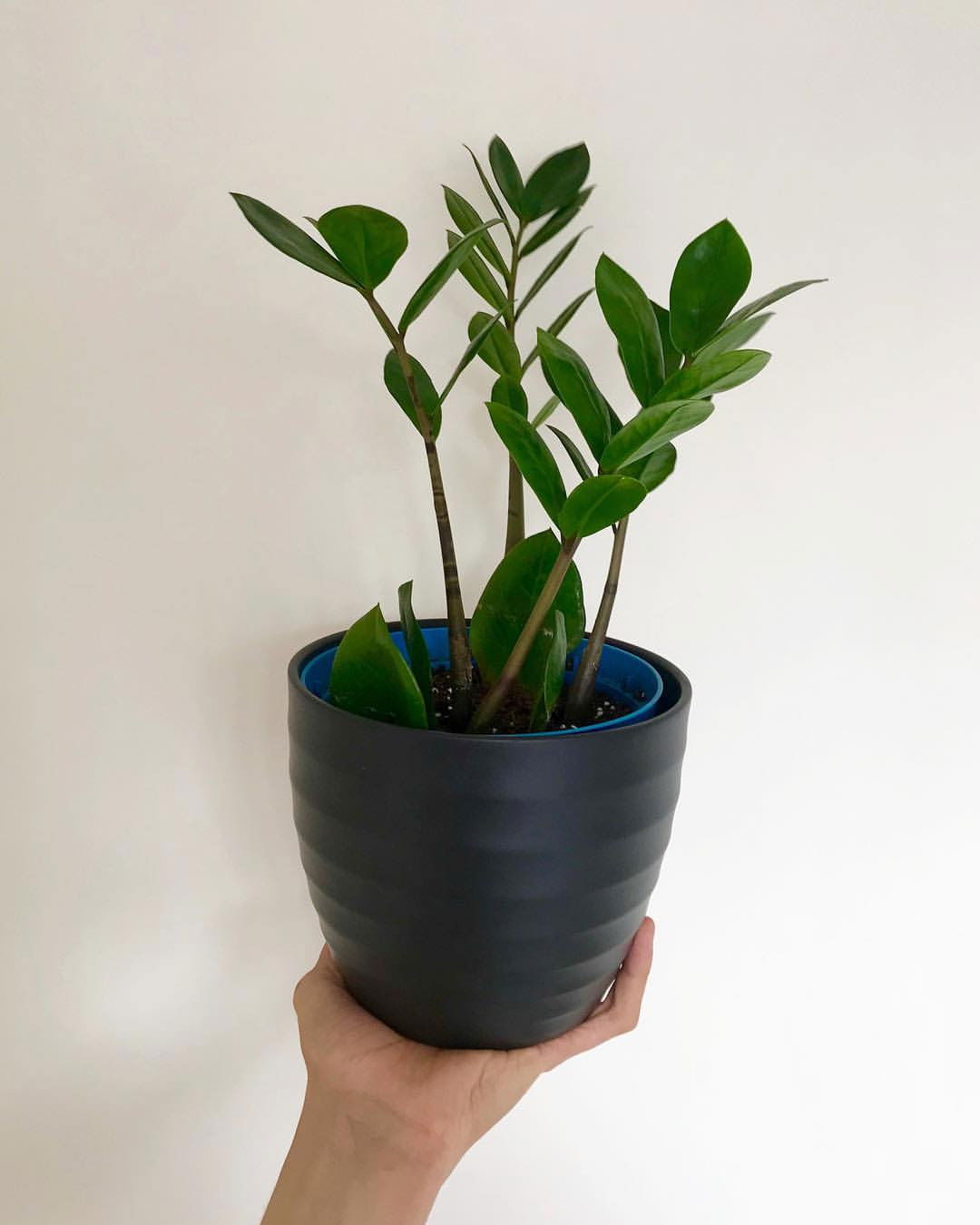
Zamioculcas zamiifolia
Contents
- Top Tips
- Light, Water, Humidity & Fertilisation
- Common Issues
- Origins, Temperature, Propagation, Repotting & Toxicity.
Are you struggling to find the answer to your specific plant issue? Book a 1-to-1 video call with THE HOUSEPLANT DOCTOR™, the website's friendly author to put an end to your stress today! Available on iMessage, WhatsApp, Facebook Messenger & more.
Top Tips & Info
- Care Difficulty - Easy
- ZZ Plants must endure dry periods between waters - if you're stuck with when to water it, think of the ukhouseplants' phrase of 'Drenches Between Droughts'.
- Be careful when watering - allowing excess moisture to sit in the cubbyholes of the lower stem will result in diseases such like stem (petiole) or tuber rot.
- Provide a bright, indirect location away from the summer sun. ZZ Plants are a great choice for statement specimens in a shady room, as long as they're kept on the drier side to life.
- Fertilise every four months all year round, using either a 'Cactus' or 'Houseplant' labelled feed. They don't need much!
- When your ZZ Plant is bought, repot it immediately into the next sized pot with a 'Cacti & Succulent' potting mix. Feel free to make holes in the pot's side with a Soldering Iron to help air circulation within the root system and soil. (See image below)
- A distorted pot shape is a sign that your ZZ Plant needs to be repotted. This occurs due to the sheer strength of the plant's tubers and root system.
- Why not buy our top-selling ZZ Plant Soil Mix here? We have sold over 1,600 batches in the last year alone, so click here to find out more...
Location & Light - 🔸🔸🔸
Although differing light levels are all acceptable, a sunny window with morning or evening sun will work wonders. Along with Pothos, Peace Lilies and Sansevieria, these are an excellent choice for dark locations, but always regulate the amount of water it receives as too much will kill the plant outright. Be sure to allow the soil to fully dry out for at least two weeks to totally eliminate the chance of soil-borne diseases. Never place a ZZ Plant is more that three hours of intense sunlight a day as its ability to bounce back from scorched leaves may take several months.
Water - 🔸
The ukhouseplants phrase of 'drenches between droughts' strongly applies to ZZ Plants. Not only will continuous soil moisture start to destroy the root system, it'll also cause the plant's tubers to begin to rot, killing it from the inside out. Allow all of the soil to fully dry out in between waters in summer for around a week or so, while reducing this further during winter. Under-watering symptoms include a weakened grey stem, yellowing leaves, little to no growth and dry, crispy patches forming on the leaf edges; these issues are usually caused by too much light/heat or forgetfulness. Remember, the brighter the location, the more watering you'll need to do. Over-watering symptoms include a weakened grey stem, leaves that have a rotten base, no new growth, yellowing leaves and plant death. The differences between under and over-watering are very similar; a rotten root ball will stop the plant soaking up vital moisture and nutrients, leaving you with wilted grey leaves. For more severe cases of root rot, click here!
Humidity -
Low humidity is fine with ZZ Plants, as long as its foliage is hosed down from time to time for the removal of dust particles and potential pests. Those situated in dark locations or bathrooms mustn't be over-misted, as it could cause powdery mildew or botrytis.
Fertilisation - 🔸
ZZ Plants need phosphorus and magnesium for optimal growth in their roots and foliage. Luckily for houseplant enthusiasts, a typical 'Houseplant' labelled feed from a local garden centre will do the job nicely. We recommend only feeding your plant three times a year due to the risk of over-fertilisation when fed too often.
 Quick Tip: Even if you don't want to repot your ZZ Plant now, create circular holes (with a Soldering Iron or screwdriver whilst the pot is empty) to improve aeration in the soil and reduce the risk of root rot.
Quick Tip: Even if you don't want to repot your ZZ Plant now, create circular holes (with a Soldering Iron or screwdriver whilst the pot is empty) to improve aeration in the soil and reduce the risk of root rot.
Common Issues with ZZ Plants
A deformed pot is the product of its strong tuberous roots travelling through the soil and therefore shouldn't cause concern. We would recommend repotting it into the next sized pot with a 'Cactus' labelled potting mix. Scroll down to 'Repotting' to learn more about what to do!
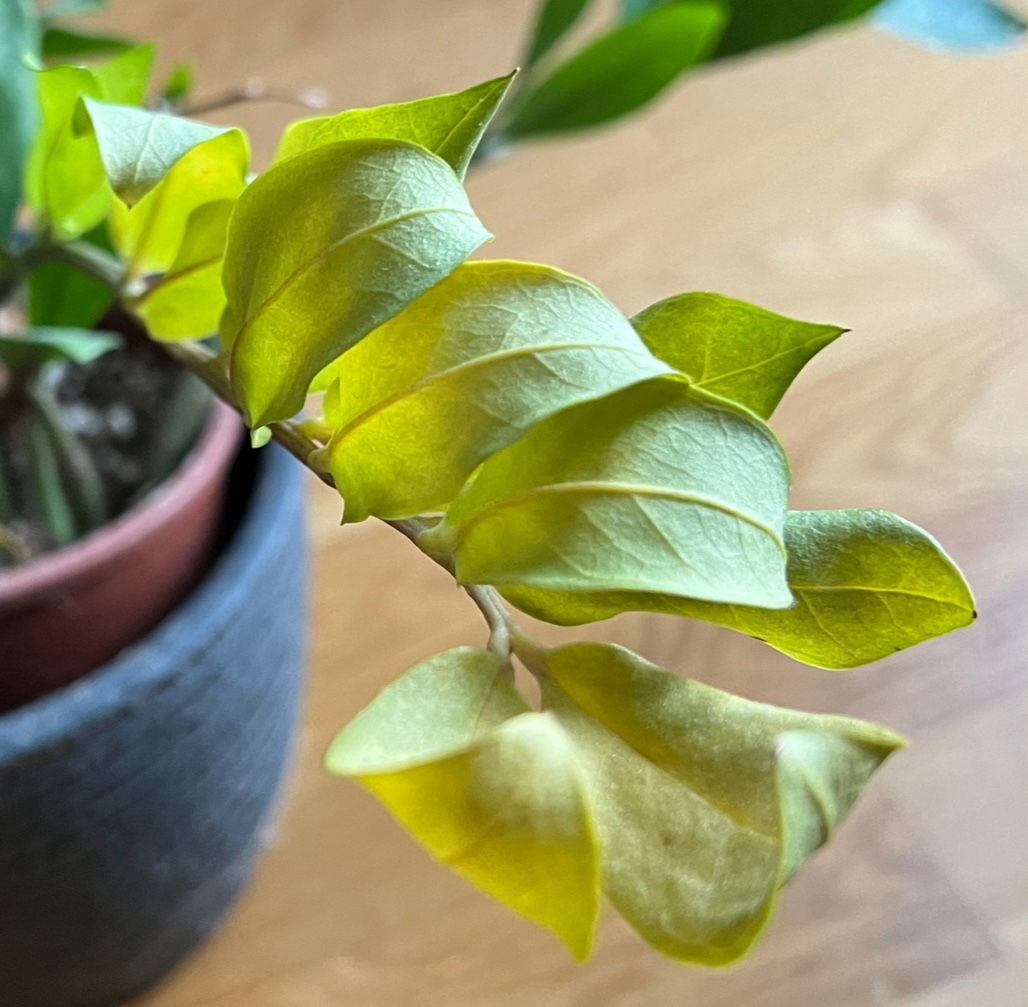 If an entire stem quickly collapses with its leaves turning yellow, this could be a sign of root rot. Check the root system for signs of brown, deflated roots like the image below.
If an entire stem quickly collapses with its leaves turning yellow, this could be a sign of root rot. Check the root system for signs of brown, deflated roots like the image below.
If your ZZ Plant's tuber has become squishy (green arrow), this may be caused by root rot (red arrow) that has dehydrated the rest of the plant. Periods of dryness is mandatory for all succulent species, especially with those that have fleshy bulbs and stems. If its root system has become rotten, prune away the affected areas and repot the plant in a smaller pot with 'Cactus & Succulent' potting mix. Keep the soil dry and avoid direct sunlight to encourage new root growth. Click on this link to learn more about root rot.

Another photo of what root rot looks like on a ZZ Plant. Typical symptoms of root rot are deflated roots that often have no pointy tip at the end.
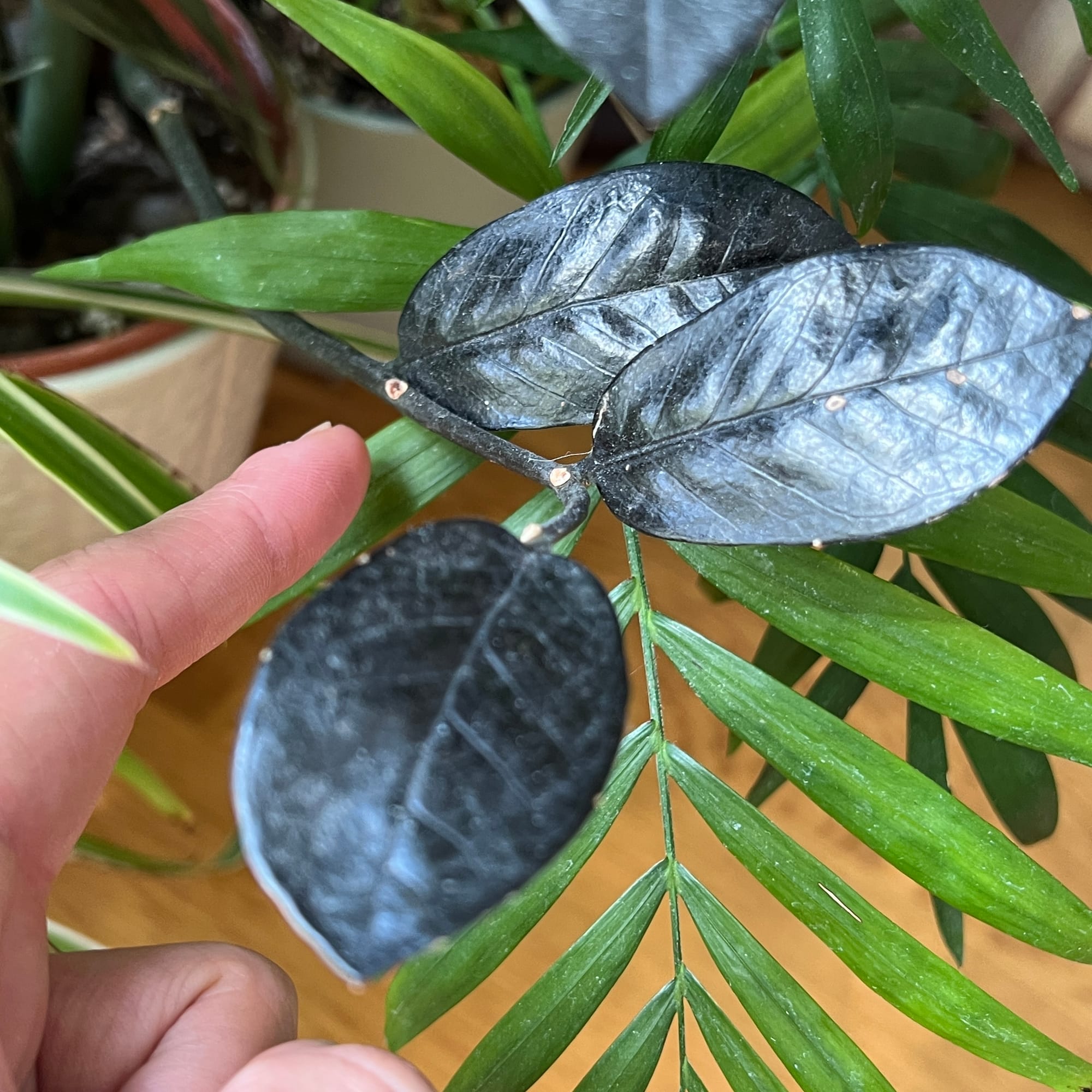
Although it's normal for a ZZ Plant to have missing leaves on its stems, there could be an underlying issue with root rot. Have a look at the roots and compare them to the image above!

White dusty markings on your ZZ Plant are just mineral deposits from hard water. If you live in an area with this, try using an aquatic water softener like 'Seachem Prime' that'll remove hard metals, minerals and chlorine. You can also use this to wipe the leaves to remove the dusty markings.
Failed propagation via leaf cuttings is a common issue among houseplant growers due to its complexity. The main reason why the cuttings have failed is down to the maturity of the plant itself. Leaves must only be removed off the petiole (the 'stem' of the ZZ Plant) once the plant has produced petioles over 40cm in total length. Those that are shorter may not produce leaves big enough to yield successful leaf cuttings so it's always better to wait at least three years of owning the plant before taking cuttings. The best length for a mature-enough leaf is around 8cm from tip to base; any smaller and it might not hold enough moisture and hormones to produce the roots and eventual tuber (it's 'bulb').
Another quick reason why the ZZ Plant's leaf isn't rooting (& instead has shrivelled/wrinkled) is due to the lack of humidity. Although they won't need 100%, you must aim for between 65-80% humidity as the leaves will need some level of moisture to avoid dehydrating.
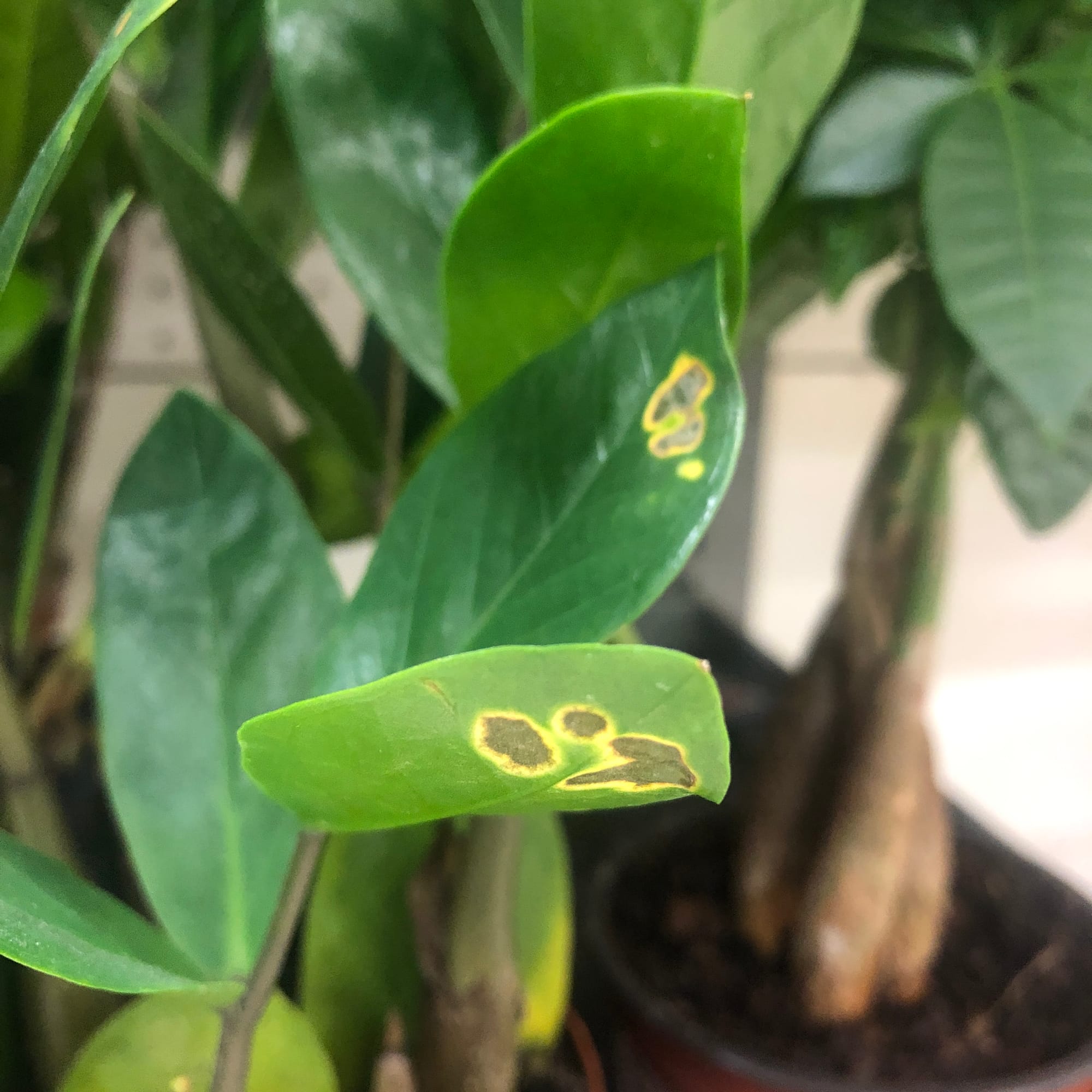 Yellowed leaf-sections with browned areas can be a product of many issues, usually wrapped up as one problem. Firstly, the location may be too dark, with its compost staying too saturated in-between waters; if mould is growing across the soil, replace the top two inches with a fresh batch of 'Cactus & Succulent' labelled potting mix. Furthermore, avoid using cold water or tap water that hasn't been allowed to sit for 24hrs due to the higher levels of chlorine. Finally, check the root system for any signs of root rot (brown or collapsed roots that are easily pulled from the plant) and repot if necessary. With its new pot, be sure to create a few holes in its side to promote better air flow within the soil and roots.
Yellowed leaf-sections with browned areas can be a product of many issues, usually wrapped up as one problem. Firstly, the location may be too dark, with its compost staying too saturated in-between waters; if mould is growing across the soil, replace the top two inches with a fresh batch of 'Cactus & Succulent' labelled potting mix. Furthermore, avoid using cold water or tap water that hasn't been allowed to sit for 24hrs due to the higher levels of chlorine. Finally, check the root system for any signs of root rot (brown or collapsed roots that are easily pulled from the plant) and repot if necessary. With its new pot, be sure to create a few holes in its side to promote better air flow within the soil and roots.
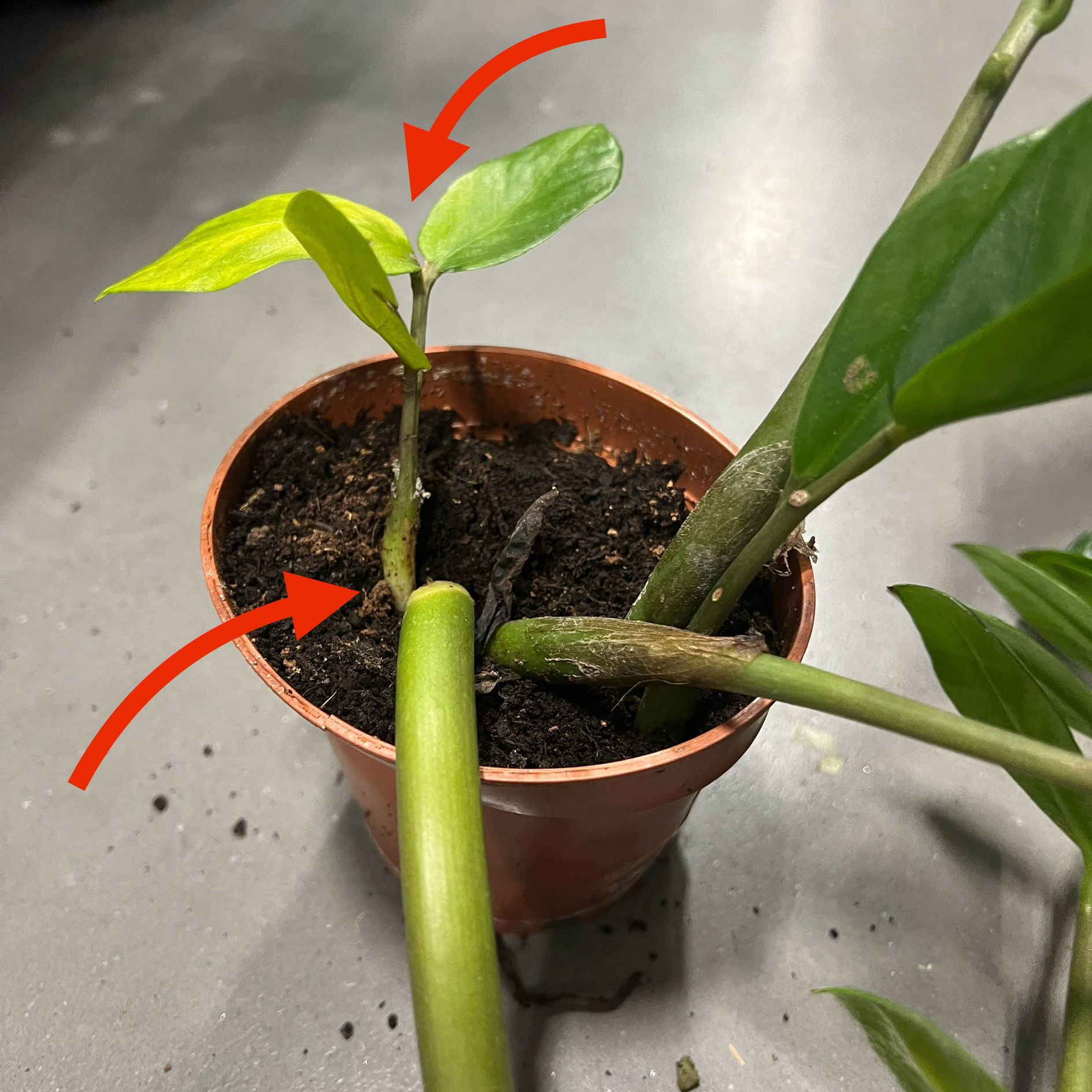 Rapidly yellowing leaves on your ZZ Plant with prolonged soil moisture (that doesn't dry quickly) could be a sign of root rot. Read the next paragraph for more information.
Rapidly yellowing leaves on your ZZ Plant with prolonged soil moisture (that doesn't dry quickly) could be a sign of root rot. Read the next paragraph for more information.
If your ZZ Plant develops basal collapse where its foliage fully wilts over, it may spell the end of its life. The tubers, which are located below the soil line and act like a modified stem, is the lifeline for a successful specimen, so any issues of rot within this bulb will kill it. Take the plant out of the pot and prune away any rotten roots and check its base for a softened profile. Remove any individual plants that have a rotten bottom and repot the healthy specimens in a fresh batch of 'Cactus & Succulent' compost. Provide a brighter location and reduce the number of waters slightly to avoid further rot. Discard the plant if there is no sign of health below the soil line, which is usually mushy with a rotten smell.
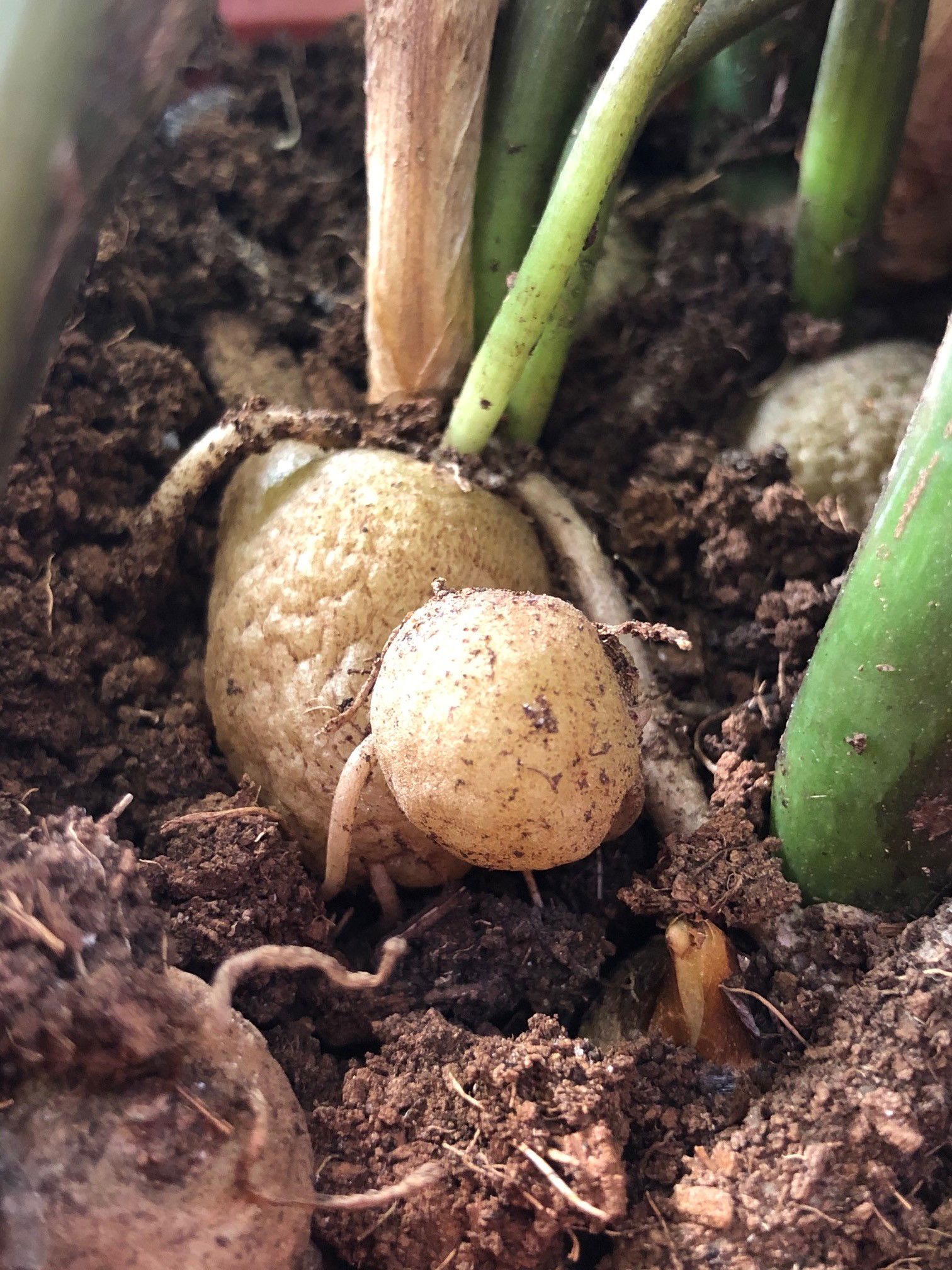 Submerge any exposed tubers by around 2cm (1 inch) with 'Cactus & Succulent' potting mix. Note: The tubers pictured above are great examples of a healthy ZZ Plant, they just need to be covered by some soil!
Submerge any exposed tubers by around 2cm (1 inch) with 'Cactus & Succulent' potting mix. Note: The tubers pictured above are great examples of a healthy ZZ Plant, they just need to be covered by some soil!
A brown crispy leaf that is wrapped around the base of the stem is nothing to worry about, as it's just the reminiscence of the 'cataphyll' that protected the bud whilst under development. Simply pull the leaf from the base to improve its overall appearance - see image above (central top) for an example of a cataphyll.

Black markings/spots on the stems of a ZZ Plant is entirely normal and doesn't imply the plant is unwell. Despite what is seen online, this certainly doesn't indicate root rot. Root rot symptoms are yellowed leaves, a wrinkled tuber (bulb) and a sudden collapse of stems. In some cases, the ZZ Plant may feel 'wobbly' within the soil (instead of being secure and fixed to the potting mix). If you feel it could have been over-watered, take the plant out of the pot and inspect the roots.
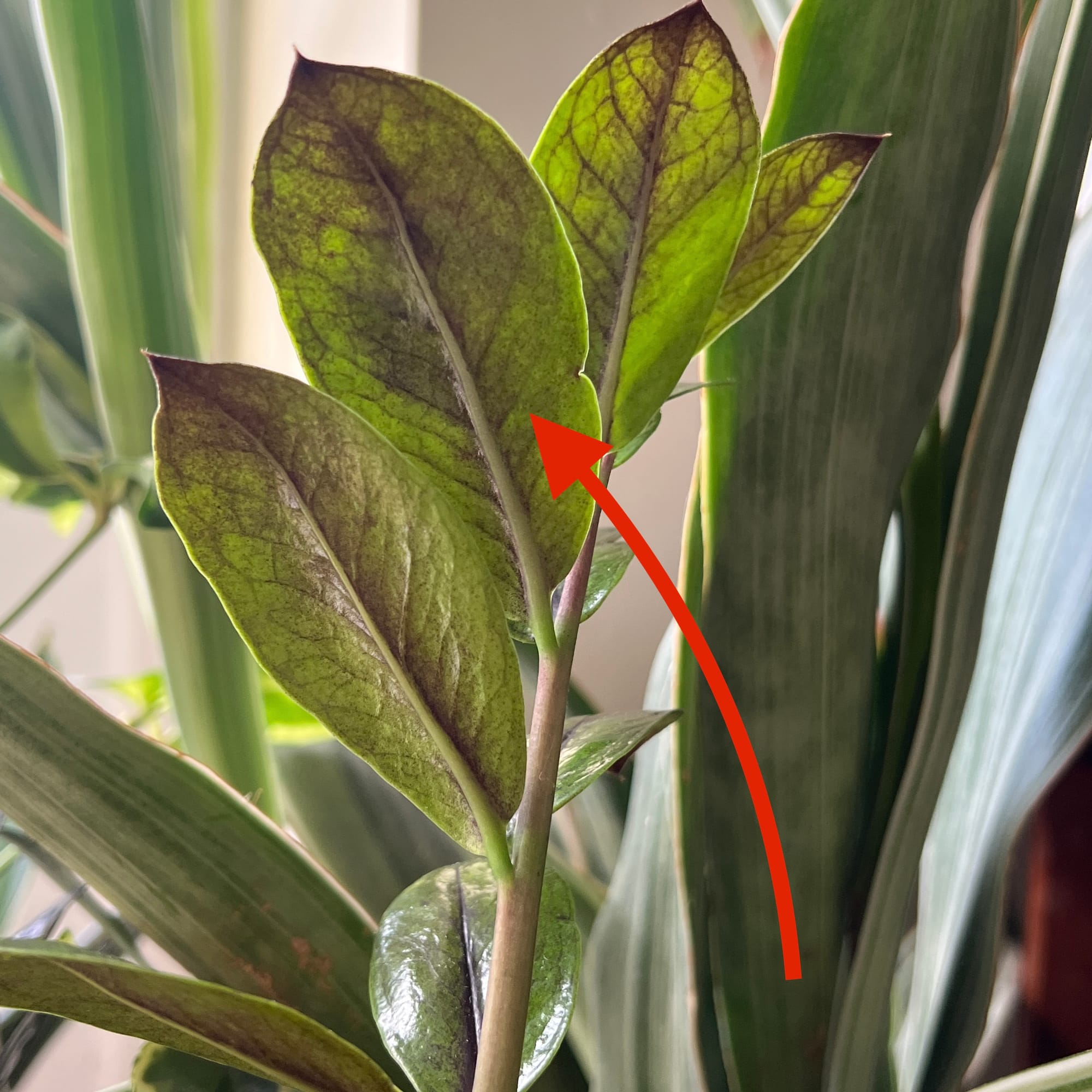
For those who own 'Raven' ZZ Plants, the newest growth will initially be green before fading into the iconic black foliage. This means that during the colour-changing phase, don't be alarmed to see the foliage look slightly brown in certain light!
Directly pinpointing yellow leaves is quite hard, due to the many different issues that could be at fault. Problems include watering-related abuse (root rot), too much or too little light or over-fertilisation. If you'd like to speak to ukhouseplants for more advice, don't be afraid to book a call with THE HOUSEPLANT DOCTOR™.
Origins
Zamioculcas is a genus of one species, the Z. zamiifolia, originating from Kenya in eastern Africa. Although the genus was first described in 1829 by Loddiges as Caladium zamiifolium but was quickly moved into the current genus by Schott; its final botanical name, Z. zamiifolia was penned by Adolf Engler in the late 19th century. The name is a nod to both the Cycas genus of Zamia, and that of Colocasias which itself has derivations from the Arabic word, culcos.
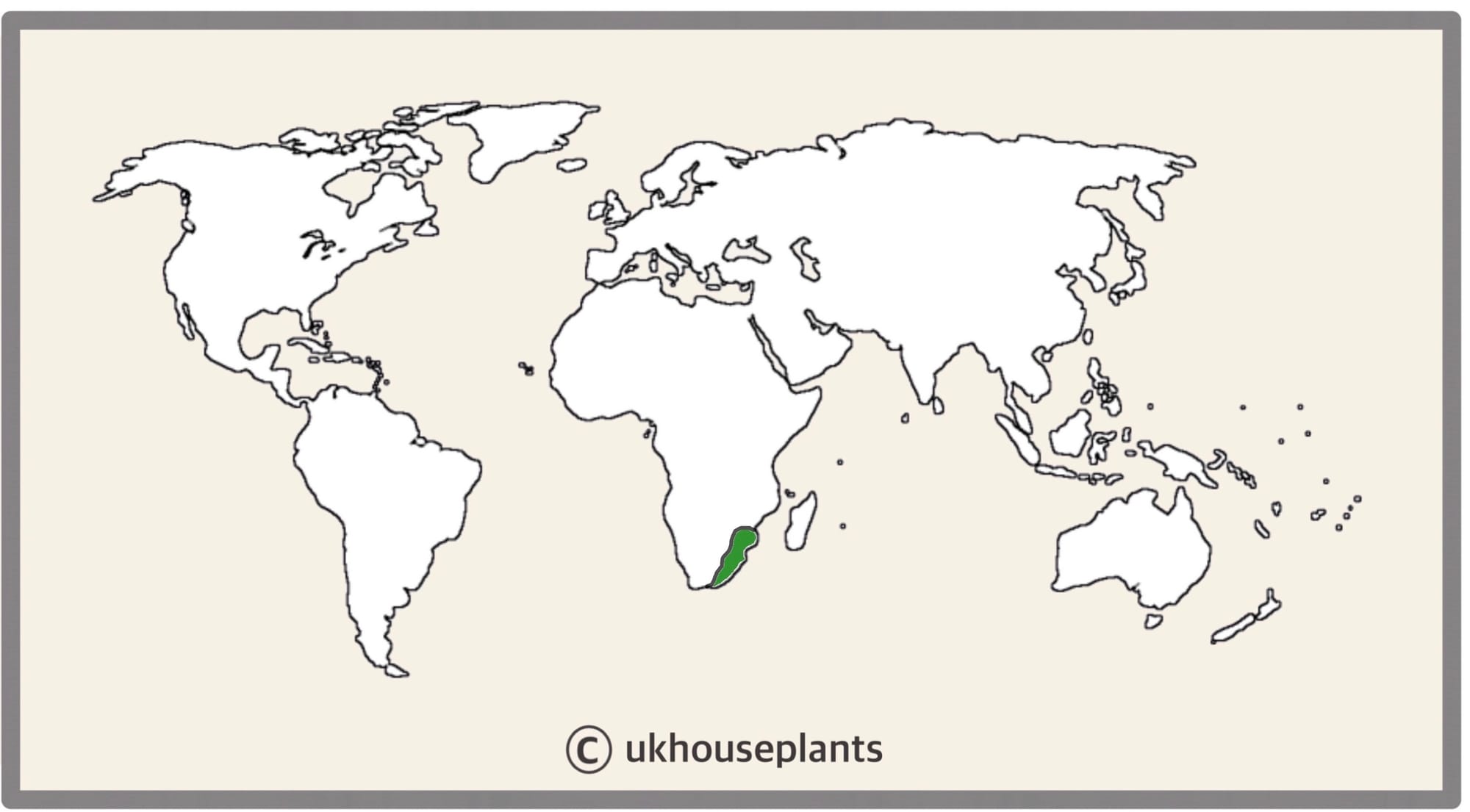 The Distribution of Zamioculcas zamiifolia.
The Distribution of Zamioculcas zamiifolia.
Temperature
15° - 32℃ (59° - 90℉)
H1a (Hardiness Zone 13) - Must be grown indoors or under glass all year round. Never allow temperatures to dip below 15℃ or permanent damage may occur in the likes of flower loss, stunted growth and yellowed leaves.
Spread
The overall size can be up to 0.8m in height and 1.5 m in width, with matured petioles reaching over 1m in length. The ultimate height will take between 6 - 10 years to achieve when repotted biannually, with two or three new growths per annum.
Pruning & Maintenance
Remove yellowed or dying leaves and plant debris to encourage better growth and all-round growing conditions. When removing dying flowers or leaves, use clean scissors or shears to reduce the chance of bacterial and fungal diseases, and remember to make clean incisions as too much damage can shock the plant.
The cataphyll may need to be removed once fully browned over; this is located at the stem's base and can be seen on the image above.
Propagation
Via Seed, Tuber Division or Leaf Cuttings.
Division (Moderate) - For this method, it's best to divide in spring or summer and once the tuberous offsets are at least half of the size of the mother plant's. If you have several established specimens within the pot, you'll have the option to individually separate them to double your stock. Always pre-water the soil at least 24hrs before propagation to avoid damaging the dry root hairs, which will lead to transplant shock and inevitable death. Remove it from the pot and place your hand in between the two tubers - soil may have to be removed to get a better grip. While placing your hand firmly around the junction, gently push the offset downwards, supporting the mother plant - you should hear a snap. Cautiously separate the two roots systems, keeping great empathise in keeping the specimens intact and damage-free. Place the new plantlet in a well-draining potting mix, much similar to the original soil, and maintain the same care routines. 'Cactus & Succulent' compost is best, or you can make your own using multipurpose compost with a generous amount of grit, sand and perlite. Make sure not to use a pot that is too big as a ratio of roots-soil that leans towards the latter will cause root rot and eventually plant death.
 If there are visible signs of rot towards the bottom half of the stem - take leaf cuttings as the disease may travel to the top. The red lines indicate where to cut for leaf propagation.
If there are visible signs of rot towards the bottom half of the stem - take leaf cuttings as the disease may travel to the top. The red lines indicate where to cut for leaf propagation.
Leaf Cuttings (Difficult) - The largest leaves on the petiole (the 'stem' of the ZZ Plant) have the most potential due to its size and maturity. Gently place your fingers between the petiole and the leaf's base, pulling it downwards until you hear a snap. Ensure the wound is wholly intact with no damage as a tear will result in unsuccessful propagation. Set the bottom half into moist 'Cactus & Succulent' compost and place the pot in a transparent bag to provide high humidity. Open it up for an hour every few days to allow fresh air to circulate the leaf. Offer a bright, indirect setting with temperatures around 18°C (64°F) with the majority of the soil drying out in between waters. The calloused base will develop into a tuber, thus signalling the propagation success. After a few months, inspect its root system and transplant into a bigger pot if necessary.
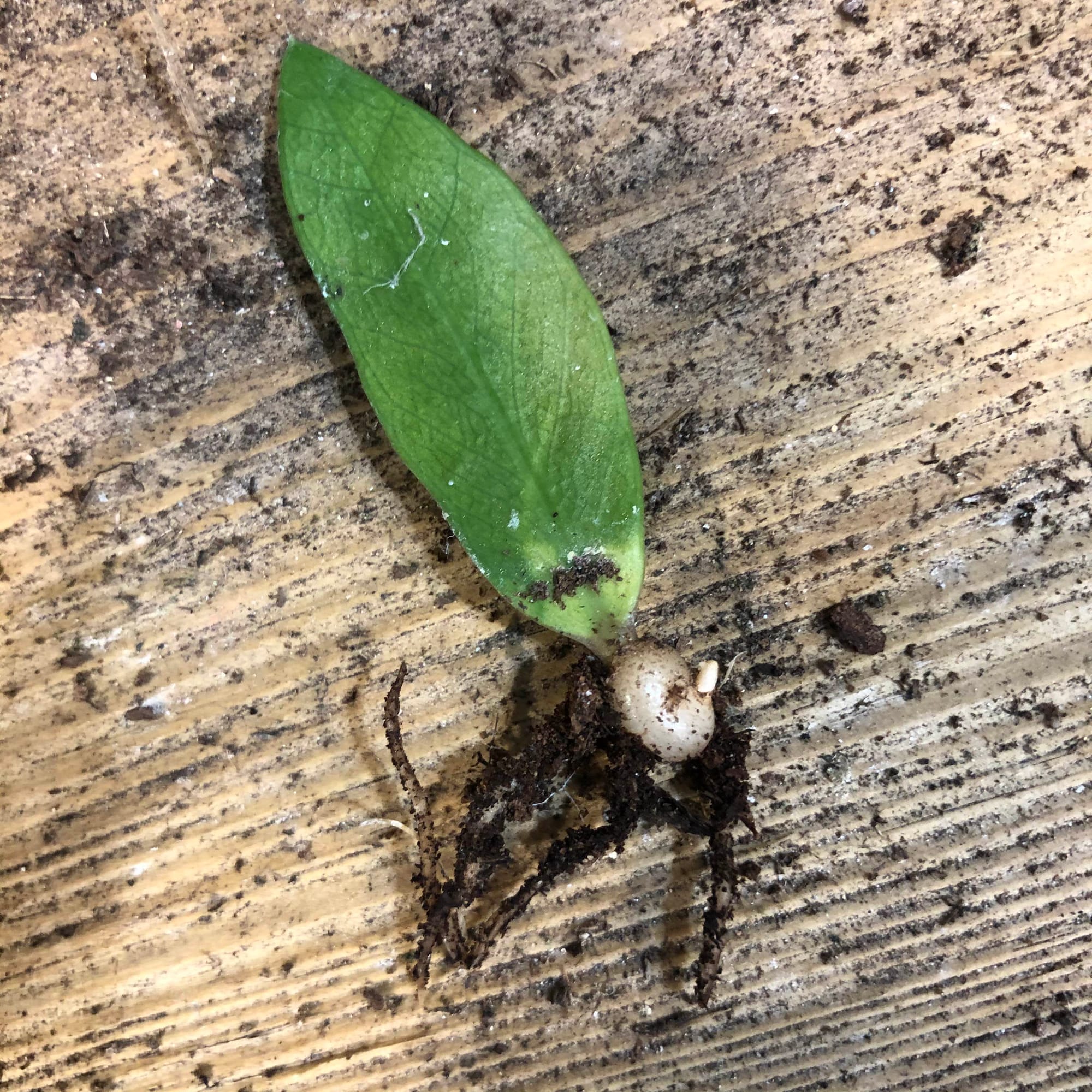 The successful development of its tuber, which will act as a 'bulb' where new growths will emerge.
The successful development of its tuber, which will act as a 'bulb' where new growths will emerge.
Flowers
As they form part of the Araceæ family, their flowers aren't showy. Much like a Peace Lily's flower body, their flowers consist of a white or green spathe (the spoon-like shell) with the spadix being the section that can be pollinated. Blooms can last up to five days and is usually visible during late spring or early summer around 20cm from the soil line. Unfortunately, producing blooms is a rare occurrence due to the unfavored growing conditions found in a typical domestic setting.
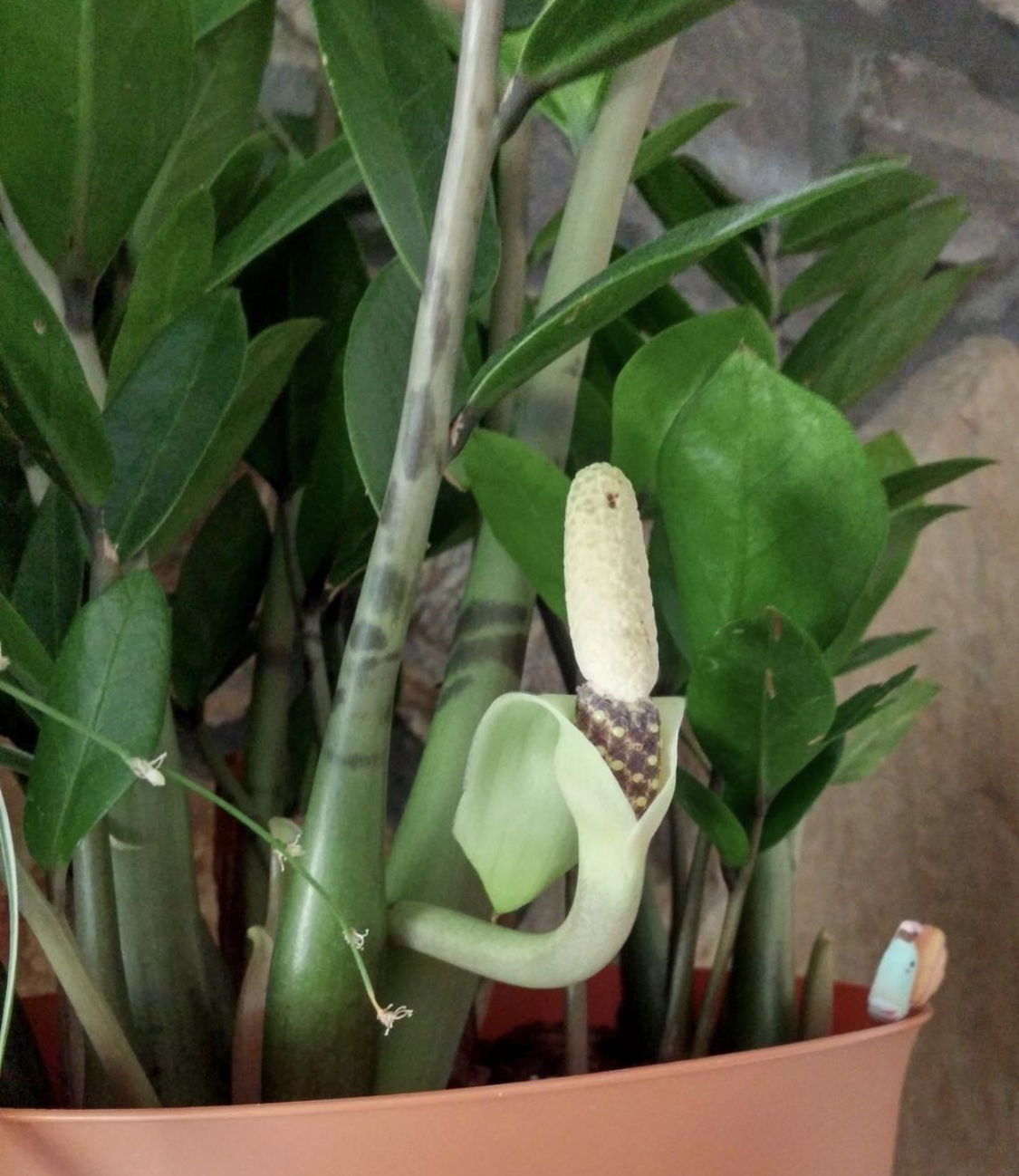 The flowers of a ZZ Plant. Copyright: Garden.org, Hamwild.
The flowers of a ZZ Plant. Copyright: Garden.org, Hamwild.
Repotting
Repot every three years in spring using a 'Cactus & Succulent' labelled potting mix and the next sized pot with adequate drainage. ZZ Plants are far better being potbound for several years due to the heightened risk of root rot and repotting-issues (like transplant shock) - so only repot if you feel it's necessary. A deformed plastic pot caused by the strong root system is entirely normal and doesn't always indicate a transplant is needed.
Hydrate the plant 24hrs before the tinkering with the roots to prevent the risk of transplant shock. For those situated in a darker location, mix in an extra amount of perlite to the potting mix to downplay over-watering risks. Click here for a detailed step-by-step guide on transplantation, or via this link to learn about repotting with root rot.
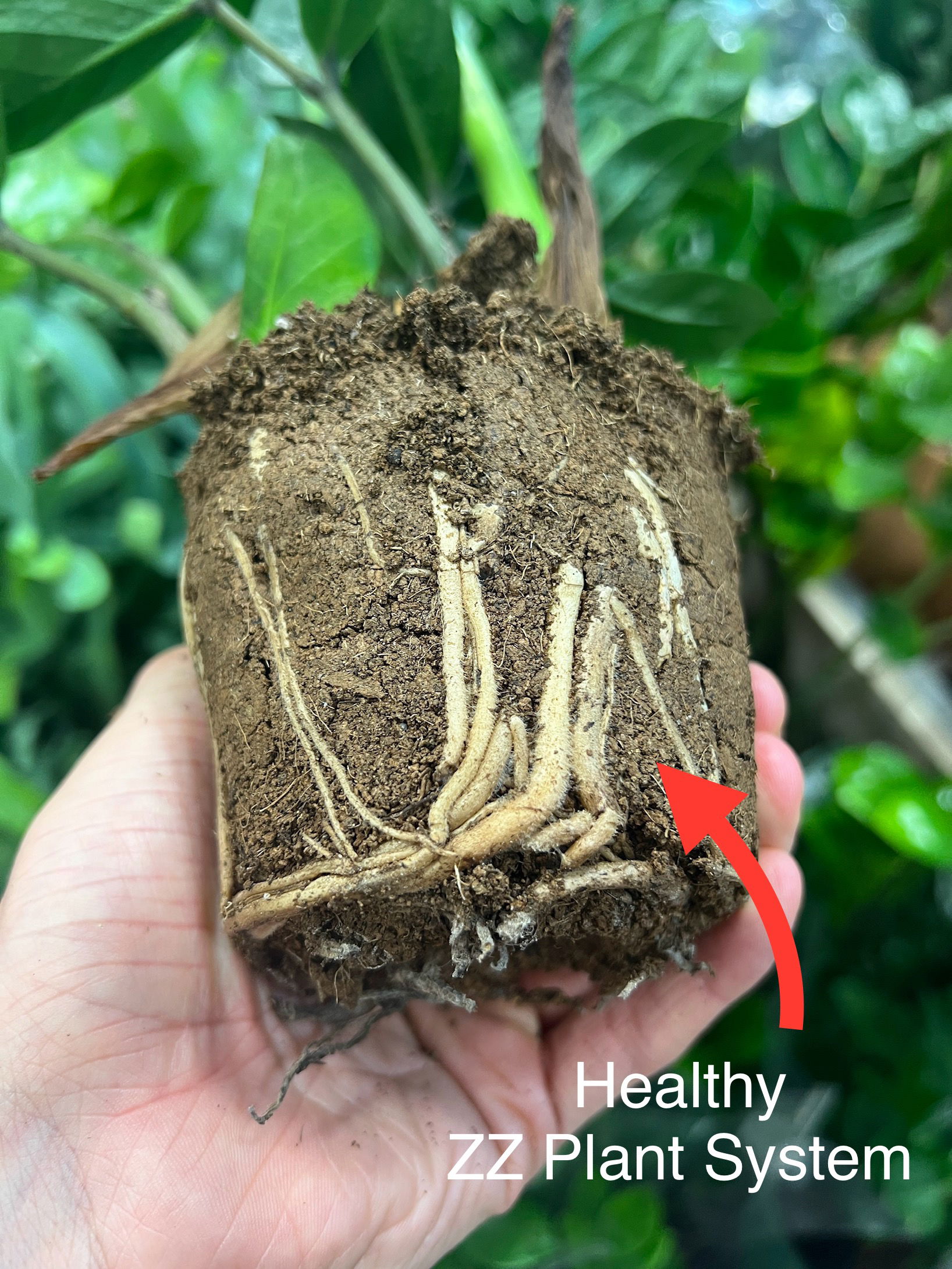
This is an example of what a healthy ZZ Plant root system should look like. Its roots will be plump when pinched, and will sport a cream-coloured tone. Scroll up to 'Common Issues' to see a photo of of root rot.
Pests & Diseases
Keep an eye out for spider mites, aphids, scale, thrips, whitefly, blackfly, vine weevils & mealybugs. Common diseases associated wth ZZ Plants are root or tuber rot, red leaf-spot, botrytis & southern blight - click here to learn about these issues.
Toxicity
Members of the Araceæ family typically contain poisonous calcium oxalate crystals, with Zamioculcas being no exception. Other members of this family include Philodendron, Alocasia and Spathiphyllum (Peace Lilies). If eaten, vomiting, nausea with a loss of appetite could occur and consumption of large quantities must be dealt with quickly.
Retail Locations
Dobbies, IKEA, Blue Diamond, Online Stores.
Book a 1-to-1 Call with THE HOUSEPLANT DOCTOR™
If you need further advice with your houseplants, book an advice call with ukhouseplants' friendly and expert writer today! This can be done via a video or audio call on most apps, including Facebook, FaceTime & Skype. A ten-minute call costs £5.99 (US$7), or £15.99 for thirty minutes. You can ask multiple questions, including queries on plants, pests, terrariums, repotting advice and anything in between. Please consider supporting this service to keep ukhouseplants thriving!